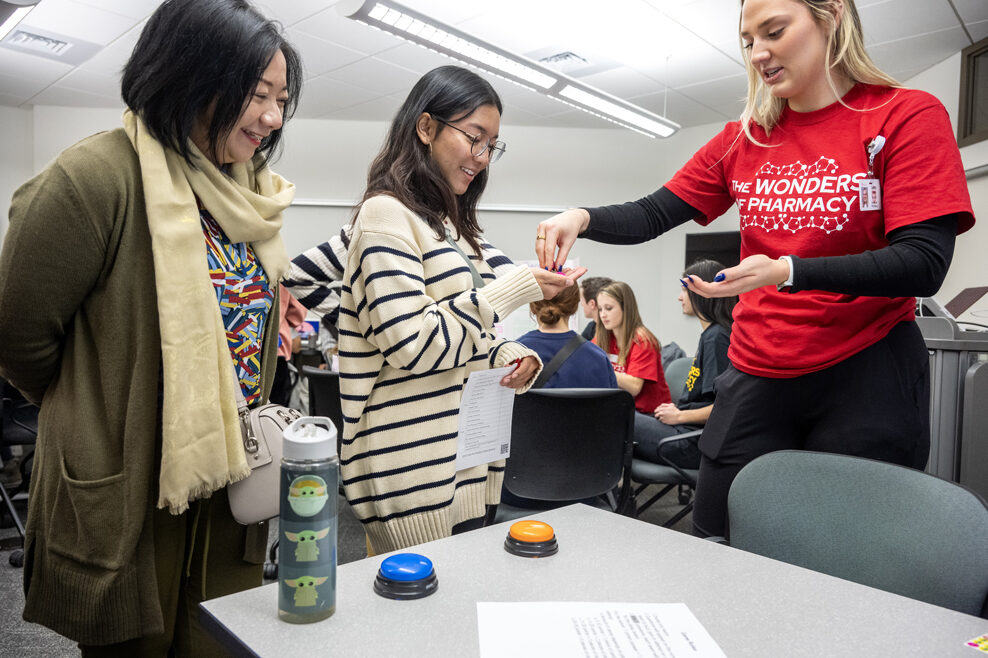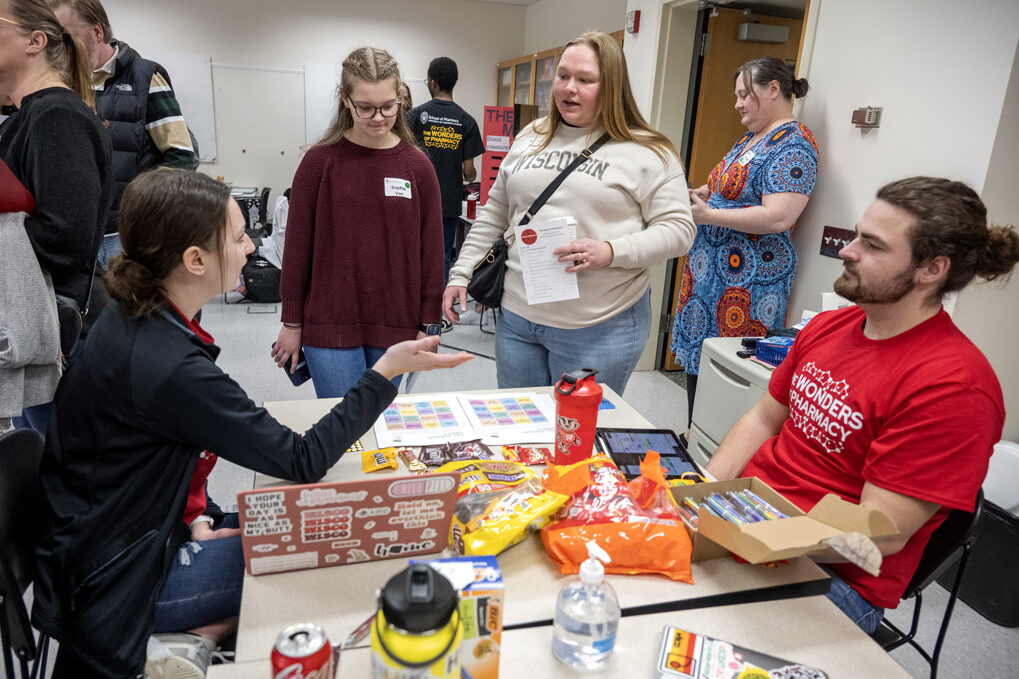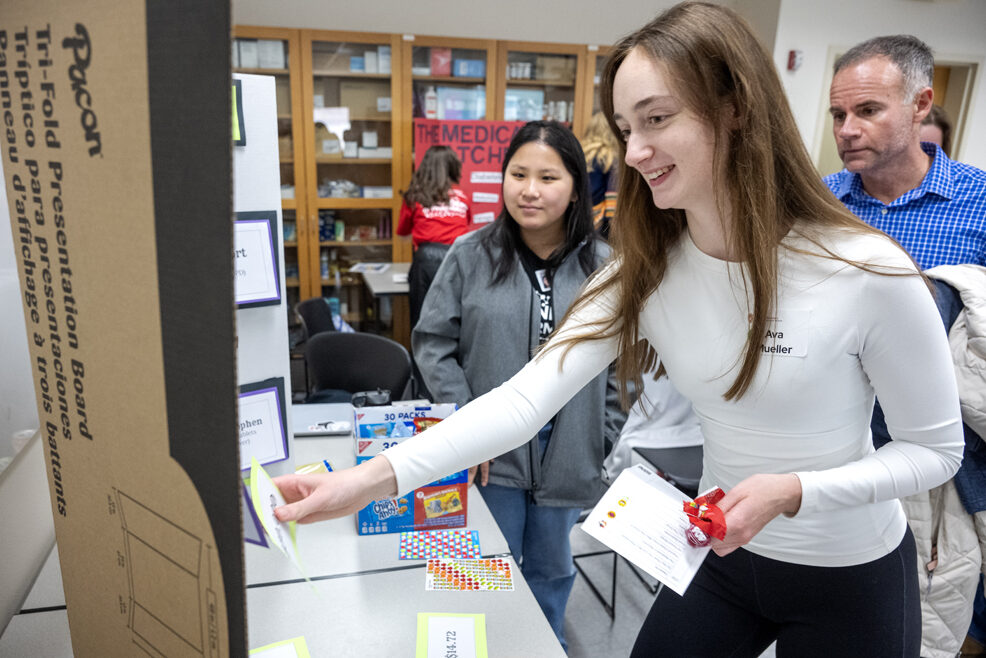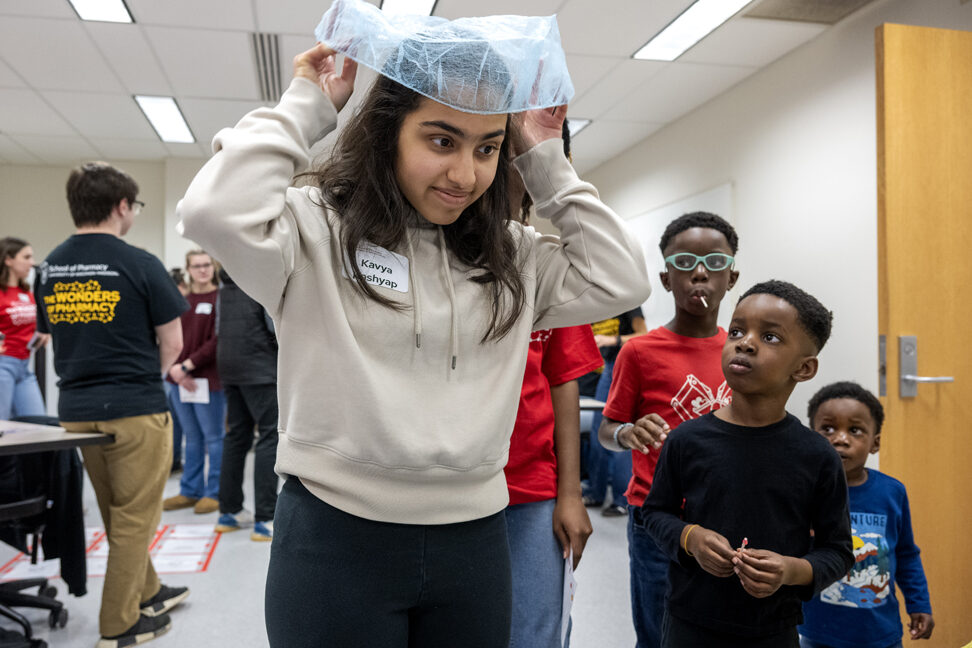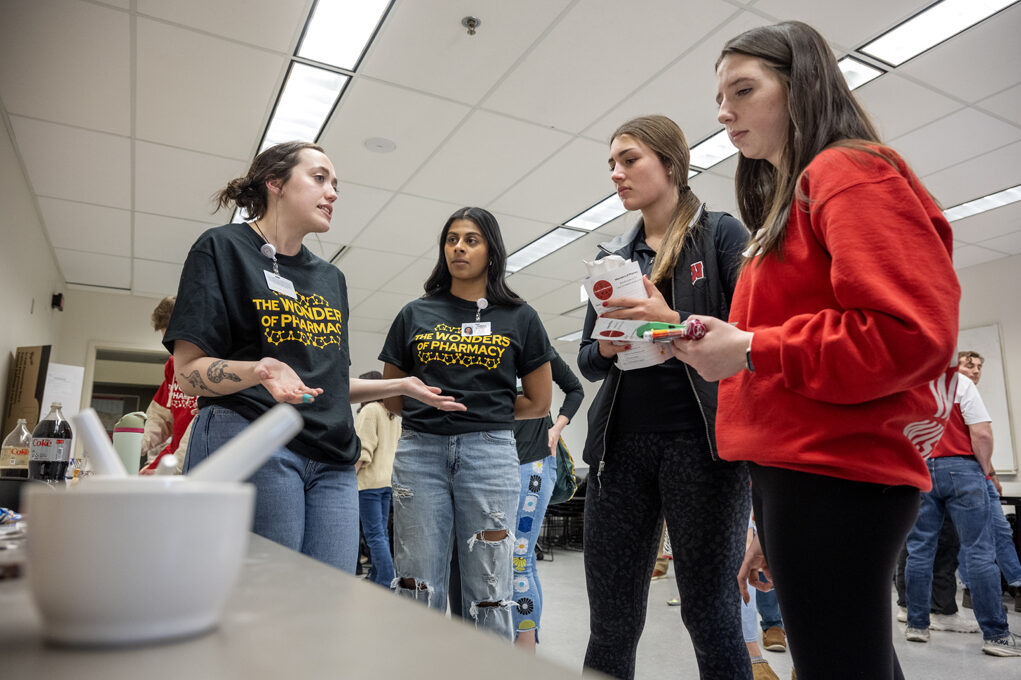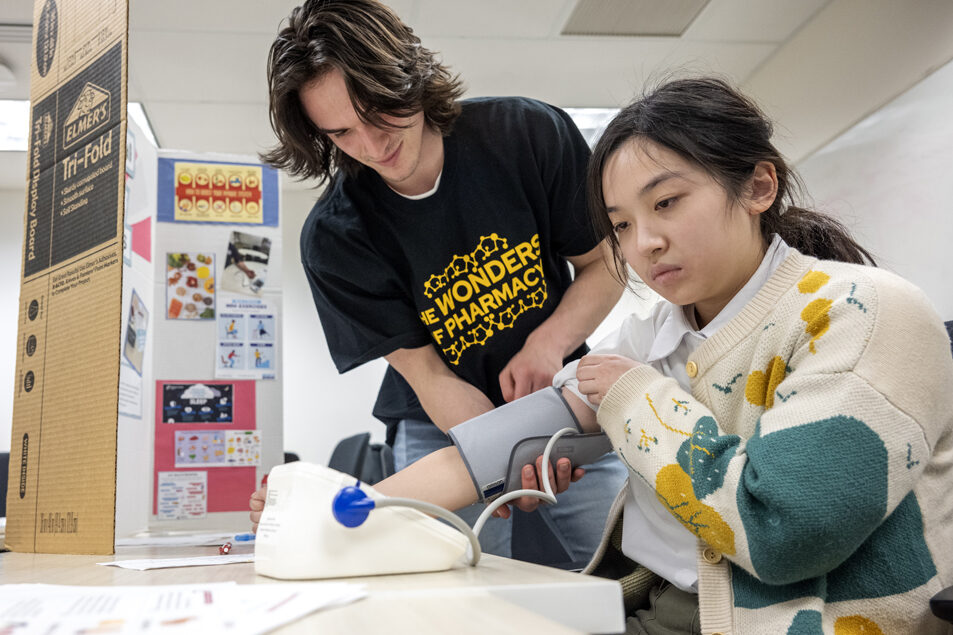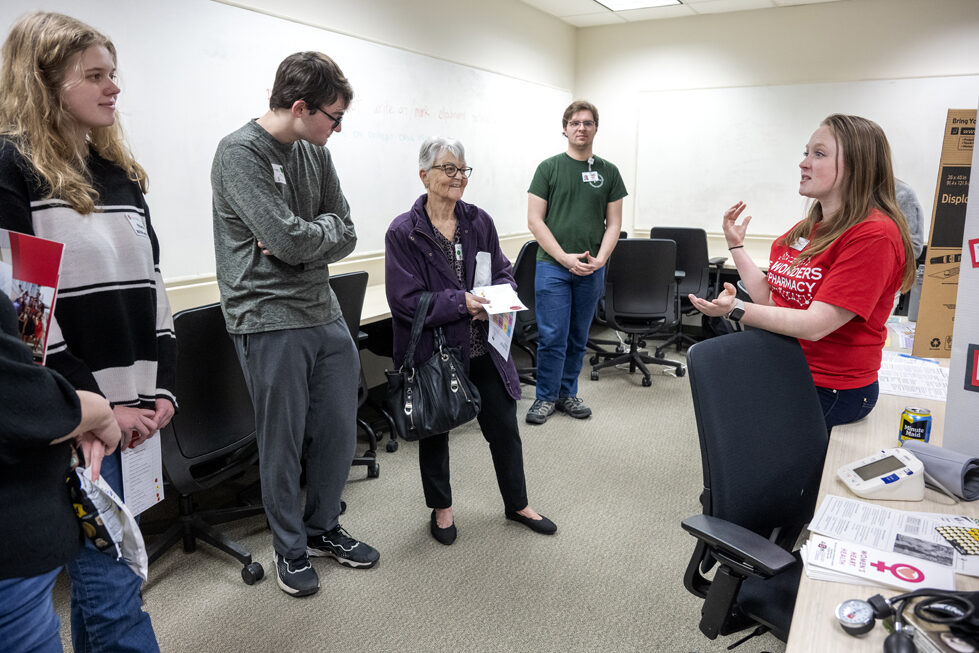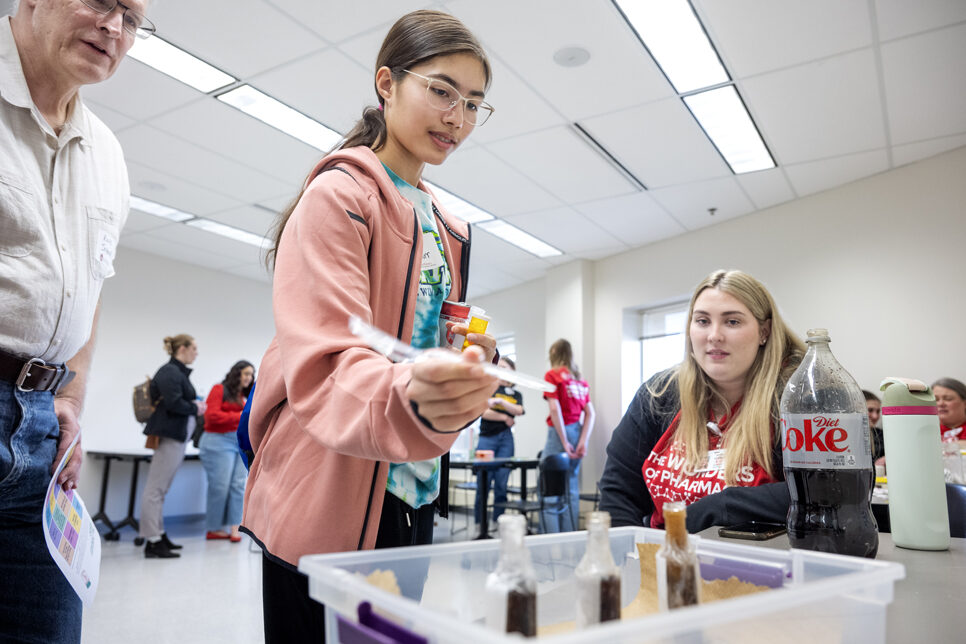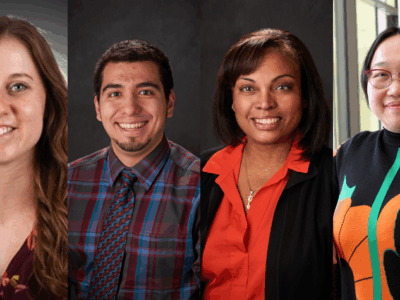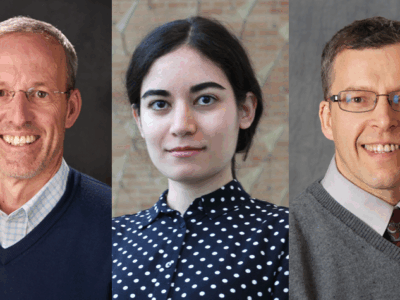
14
March

A new event organized by Associate Professor Olufunmilola Abraham and School of Pharmacy students aims to inspire high school students about pharmacy careers
By Maren Stewart
“I can be making a difference from day one. I can be changing and impacting my community.”
This is the sentiment that Olufunmilola Abraham (MS ’11, PhD ’13), associate professor in the University of Wisconsin–Madison School of Pharmacy’s Social and Administrative Sciences Division, aimed to inspire in high schoolers through a brand-new event. The Wonders of Pharmacy shared not only the breadth and scope of pharmacists’ roles, but also the reasons why pharmacists were drawn to the field.
“Young people need deeper reasons, more meaningful reasons to want to be pharmacists,” says Abraham. “They want to understand that they can make a difference.”
To share an up-close look at what pharmacists do and how they impact the lives and health of their communities, Abraham partnered with the PharmD students in her Collaborative Research on Medication use & family health (CRoME) research group to produce experiences that the attendees won’t forget.
“The event proved to be impactful in educating high school students on the roles a pharmacist can play in community pharmacies, healthcare systems, academic institutions, and the pharmaceutical industry,” says Quinlan Alfredson, a second-year PharmD student on the CRoME team. “The quality and creativity of each station truly showcased the effort and enthusiasm put forth by the presenters.”
Sparking an interest
The genesis of the new event can be traced back to Abraham’s experiences with the Wonders of Physics, a hands-on exploration created by UW–Madison Physics Professor Emeritus Clint Sprott and meteorologist Haddie McLean, where Abraham marveled at the simplicity and allure of science education for children.
“I have to give Clint and Haddie credit,” says Abraham. “I was so fascinated by how they made physics simple for kids to understand.”

Abraham’s research at the School of Pharmacy is woven together by the same thread: communicating important information to youth. Her CroME team — which includes researchers, PhD and PharmD students, and high schoolers, among others — is dedicated to advancing medication safety and health behaviors within vulnerable populations, primarily kids and young adults. From creating video games to share information about opioid safety with teens to educating middle schoolers about cancer etiology, opening a dialogue with youth is one of Abraham’s passions.
“My research is heavily focused on community engagement, thinking about how we can engage community stakeholders — we do a lot of work with kids and adolescents — and teach them about pharmacy and safe medication use,” says Abraham. “Now we’re using that mindset to understand how to bring them into the pharmacy world.”
Across all of her projects, Abraham aims to elevate the voices of youth in order to better understand and communicate with them. For the Wonders of Pharmacy, that means she is empowering PharmD and prepharmacy students to get creative to plan the event.
“This is really run by undergraduates and first- and second-year PharmD students,” says Abraham. “They have equal input and voice, and they’re telling us what can spark that interest and curiosity in the pharmacy profession.”
“Something that I think is unique is that it’s not just us saying, ‘This is what you need to know about pharmacy.’ It’s remembering, ‘When I was a high schooler, why did I fall in love with pharmacy?’”
—Olufunmilola Abraham
The event doesn’t just showcase what pharmacists do, says Abraham. Instead, it aims to highlight the reasons why people are drawn to it.
“Something that I think is unique is that it’s not just us saying, ‘This is what you need to know about pharmacy,’” says Abraham. “It’s remembering, ‘When I was a high schooler, why did I fall in love with pharmacy?’”
To further understand high schoolers’ perspectives, she brought them to the table to share feedback throughout the planning process.
“We have three students from different high schools who are leading the charge, saying, ‘This is what I would like to learn, this is what I wish I knew,’” she says.
“We’re bombarded with so many options of what our future holds that casually showing another in a fun manner is something that I would love to see,” says high-school student Oluwadara Fadiran. “I hope more students now see what pharmacy is; it’s so much more than just making drugs or packing them into bottles.”
In a pharmacy wonderland
Across 30 stations, each hosted by UW–Madison student pharmacists, more than 100 attendees were treated to different facets of pharmacist impact. Six of the booths are hosted by student organizations, including the Wisconsin Society of Pharmacy Students’ Operation Airways, Operation Immunization, Operation Substance Use Disorder, Operation Heart, and Operation Medication Safety.
“That’s a big one for us because we know a lot of high-schoolers use over-the-counter medications but may not know how to use those safely,” says Abraham.
Four other stations showcase the CRoME team’s work, including their educational video games about opioid safety and cancer prevention. The remaining stations present retail pharmacy simulations, “Price is Right” style games about medication prices, a guessing game to learn what pharmacists have invented, a compounding simulation, trivia games, and more.
“It’s like a choose-your-own-adventure scavenger hunt where participants go to find different stations to win prizes,” says Abraham.
Third-year PharmD student Courtney Koeberl hosted a booth about pharmacist involvement with contraceptives, but her conversations with the students went beyond the prescribed topic.

“While the students at the Wonders of Pharmacy enjoyed my booth on contraceptives, they also took the time to ask for advice on how to best prepare for college,” says Koeberl. “I felt that I really connected with the high school students because I was in their shoes once. Since sixth grade, all I ever dreamed of was becoming a pharmacist. I first toured the UW Madison–School of Pharmacy when I was a sophomore in high school. The faculty and students I met that day were so inspiring that I instantly knew I belonged in this school.”
The stations also featured another benefit: School of Pharmacy alumni and practicing pharmacists. Susan Kleppin, pharmacist consultant with UW Health Care Direct, was one of nine alumni and pharmacists who joined PharmD students at the booths, sharing their perspective on their careers. She was excited to share with high schoolers what a degree in pharmacy can enable.
“I recently transitioned out of my Director of Pharmacy role here and in reflecting on my upcoming retirement, I have an even deeper appreciation for my chosen career path, for my education at the University of Wisconsin, for my involvement in professional organizations and for the opportunities that I have had to positively impact patient lives,” says Kleppin.
Another alum, Debbie Gillard (BS ’93, PharmD ’96), an ambulatory care pharmacist in the anticoagulation and anemia clinics at Froedtert Health, also appreciated the opportunity to connect with parents.
“It was a great opportunity to answer parents’ questions and share information about the wide variety of practice sites within the pharmacy profession,” says Gillard. “The student pharmacists did a wonderful job of presenting information at their respective displays in a way that was engaging, fun, and informative.”
“The community was amazingly receptive to this idea, and the pharmacists we contacted were enthusiastic to help facilitate engagement with student displays,” says Zachary Paulson, a third-year PharmD student on the CRoME team.
By providing a space for storytelling and reflection, the event empowered pharmacists to showcase the multifaceted nature of their profession.
“We wanted high schoolers to think, ‘I can own my own business, I can work in industry and do drug discovery, I can be in academia’ — we wanted to expand their minds in terms of the possibilities, helping them understand we were just like them,” Abraham emphasizes. “We want the high schoolers to see that diversity. You can bring your unique self and that can be represented in pharmacy.”
Keeping the wonder alive
Although the event is complete, Abraham has plans to keep demystifying pharmacy careers. To help reach youth nationwide with information about pharmacy careers, Abraham is creating a podcast to continue amplifying the voices and stories of pharmacists, with help from Koeberl.
“The podcast will feature pharmacists across various disciplines, such as community pharmacy, pediatrics, and even academia,” says Claire, a high-school student who helped plan the Wonders of Pharmacy. She is now working with Koeberl and others to create the podcast.
“The interviews are meant to give anyone who may be interested in learning about pharmacy the chance to hear about the reality of the field, including the contributions pharmacists make and diverse challenges they face in their day-to-day responsibilities,” she says.
“You can bring your unique self and that can be represented in pharmacy.”
—Olufunmilola Abraham
Koeberl similarly hopes that the podcast will highlight the scope and significance of pharmacists’ roles, as well as inform changes in the workplace.
“I intend for pharmacists to share insights into fostering their well-being and capacity to deliver exceptional care to patients and their families,” says Koeberl. “I seek to emphasize recommendations for enhancing work environments and policies affecting pharmacy practice.”
To Abraham, illuminating the Wonders of Pharmacy and helping to interest young people in becoming tomorrow’s health care professionals is part of the Wisconsin Idea.
“Students are at the heart of everything we do. We say we are about training the next generation of teachers, scientists, and pharmacists,” says Abraham. “Our work is not just about research and publications, but also about giving back to the community and weaving them into the learning process. That makes our research even better because we are connecting with our communities where we live and work.”



















